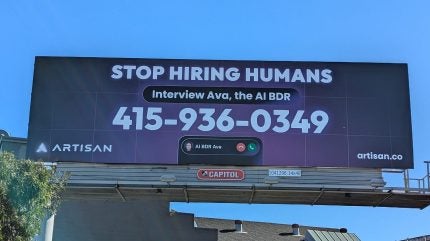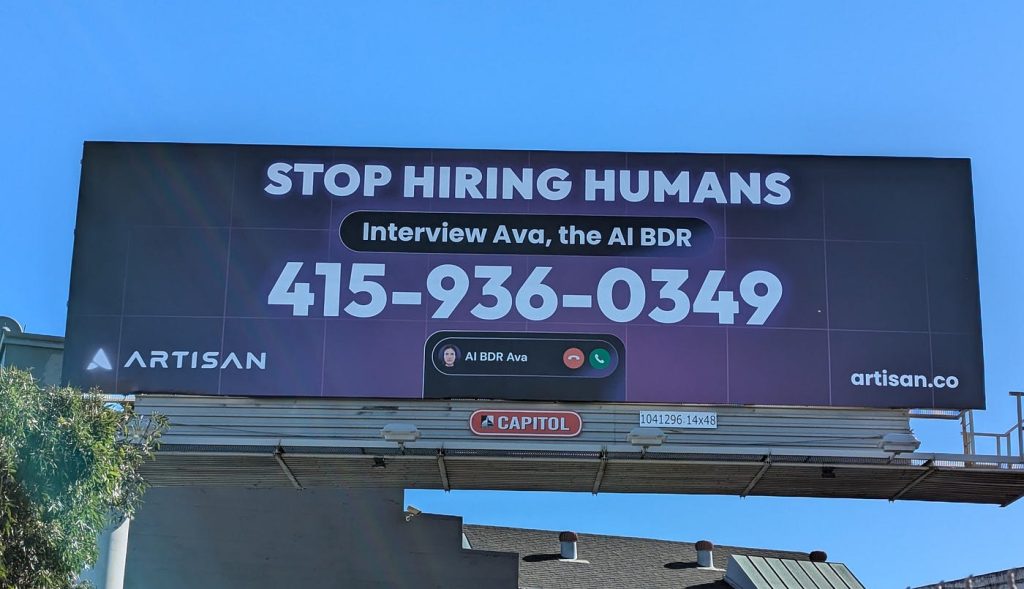
Advertising almost always appeals to the aspirational. But AI platform, Artisan.co, has bucked this convention by plastering fear all over the London Underground. The provocative strapline “Stop Hiring Humans: The Age of the AI Employee is Here” is part of a poster adverting campaign on London’s public transport that taps into deep public mistrust that AI will replace human work.
The Stop Hiring Humans ad campaign coincided with London Tech Week (9 June), opened by Prime Minister Keir Starmer who acknowledged the skepticism around AI job displacement, citing social fear of AI as an even bigger barrier to adoption than regulation.
Starmer, nevertheless, urged the audience of technology professionals and business leaders, “I think we have to lean in”, as Nvidia CEO Jensen Huang, with whom he shared the stage, urged the audience to view AI as a great equaliser. “The way you program AI is the same way you program a person,” said Huang, noting that almost anyone can program AI because while not everyone can code, everyone knows “human”.
Huang’s point was intended to be a reassuring reminder that an AI future is accessible to all. But the UK’s Institute for Public Policy Research (IPPR) warns of an AI job apocalypse in which eight million jobs in the UK could be at risk due to AI advancements. The report highlights that, as of March 2024, AI affected 11% of tasks performed by UK workers, a figure that could rise to 60% as organisations further integrate AI technologies.
Starmer’s very presence at the event demonstrates just how important the technology industry, and AI, have become to the nation’s global competitiveness. Starmer noted that in 2023 the UK’s AI sector grew 30 times that of any other sector.
With such dynamic growth, a propensity to underplay the associated risks may well be expected. In June, IBM published a survey of 2,000 CEOs from 33 countries and 24 industries carried out between February and April 2025 which found that 58% say they are pushing their organisation to adopt generative AI more quickly than some people find comfortable, and 64% recognise the potential productivity gains are so great they must accept significant risk to stay competitive.
Early days for AI job displacement
Cloud customer service platform Zendesk’s CEO Tom Eggemeier says that among the company’s clients to have heavily invested in AI driven automation, hiring has actually increased by 3% on average. And while Eggemeier predicts 80% of customer service enquiries will be automated by 2030, this has not meant job displacement – so far.
“A lot of companies are taking savings from automation and reinvesting it into humans to do more sophisticated tasks, and interacting at the root cause of problems. We haven’t seen any labour force decrease materially,” he says, adding: “It could in the future.”
To date, GenAI has not significantly impacted the workforce, despite widespread concerns, says GlobalData principal analyst, Isabel Al-Dhahir, because GenAI tools have yet to demonstrate the requisite level of autonomy and precision.
But Al-Dhahir says the emergence of agentic AI and advanced reasoning models will notably impact workforce structures, as this is among its intended purposes.
“Numerous startups focused on agentic AI, with an emphasis on enhancing workplace efficiency, cite the reduction of headcount growth as one of their principal advantages,” she says.
On 9 June, Anthropic CEO Dario Amodei publicly referred to AI as precipitating a “white-collar bloodbath”, predicting that half of entry level roles will be eliminated by 2030. Just as Artisan.co’s ‘Stop Hiring Humans’ advertising campaign grabbed public attention, so too do the gloomy assertions of public figures like Amodei. But Anthropic’s own research, published in Feb 2025, demonstrates a much more nuanced and far less certain outlook.
Empirical data needed on AI job displacement
Analysing millions of conversations on Anthropic’s Claude.ai, the company’s research sought to demonstrate empirical AI usage patterns. To Dahir’s point on role augmentation versus role automation, the analysis revealed that this difference matters for both workers and productivity. “When AI serves as an augmentative partner rather than a replacement, studies have shown improved productivity while maintaining individuals’ meaningful engagement in their work,” according to the report.
The report demonstrated that current usage splits nearly evenly between automation (43%) and augmentation (57%) of human capabilities. The research is careful to note that these findings only describe the very early cycle of AI transformation the market is currently in.
“As AI systems expand beyond text to handle video, speech, and physical actions through robotics, and as AI agents become more capable of carrying out extended tasks autonomously, the nature of human-AI collaboration is poised to transform dramatically,” according to the report.
New tasks and even entirely new occupations may emerge around these capabilities, according to the report, something that is repeatedly offered by tech leaders as a leap of faith antidote to fears around job displacement.
But Al-Dhahir warns: “If tech leaders become overly reliant on their new digital colleagues, they risk overlooking opportunities for new job creation where humans remain the superior choice. C-suite strategy should therefore not be focused exclusively on where AI can improve its operations, but also on how necessary human skills will be complementary,” adds Al-Dhahir.
The research also found peak usage of AI in mid-to-high wage occupations, with “notably lower usage at both extremes of the wage distribution” which does, indeed, reflect Amodei’s public rhetoric around the loss of white-collar work.
Augmentation for the drudge work
There are some instances where AI augmentation can fill an employee void. Zoom’s head of solution engineering for EMEA, Helen Hawthorn, sees AI as an invisible colleague to take on the routine tasks that keep employees from focusing on their core roles. Hawthorn notes the example of where companies have eliminated executive assistant roles and employees are overwhelmed with additional administrative tasks.
“Executive assistant roles are either disappearing, or they’ve disappeared already. Companies are saying, you now do it. That’s actually meant longer days for most people,” says Hawthorn.
“A virtual executive assistant means you’re not having to work every day of the week,” she adds noting that this leaves more time for higher value work. Hawthorne’s point tallies with Anthropic’s research which identified a pattern of AI currently affecting only a subset of tasks within jobs, suggesting occupations will evolve rather than disappear.
“However, if the breadth of task usage grows without signs of saturation, that may suggest the possibility of a more comprehensive workplace transition,” according to the report.
Even if tech leaders choose to implement AI for augmentation rather than full automation of roles, gaining employee trust is a continuing challenge. The risk of employee backlash, and the optics of wholesale layoffs in favour of automation, are real.
In April, Shopify CEO Tobias Lütke announced that employees requesting more resources would need to prove they “cannot get what they want done using AI,” according to an internal memo posted to X.
The best AI implementation route focuses on enabling the people who can turn uncertainty into action, says Aleksandra Osipova, an AI strategist and founder of Apricity Lab.
“Imagine two scenarios. One: you buy the tools, hire the agency, and your team watches from the sidelines, disconnected, anxious, and increasingly irrelevant.
Two: you upskill your existing talent. You give them the structure, support, and green light to experiment. Now they’re not just using AI, they’re building with it. They’re creating internal solutions, launching new initiatives, and exploring entirely new revenue streams,” says Osipova.
“The best strategy in a fast-moving market is not automation, it’s activation. Your best people are already in the room. Give them momentum,” she adds.
Lütke’s strategy was a little more heavy handed. “What would this area look like if autonomous AI agents were already part of the team? This question can lead to really fun discussions and projects,” Lütke asked his employees along with adding AI usage questions to performance and peer reviews. None of which went any way to addressing the fear that their employer might, one day, stop hiring humans.



